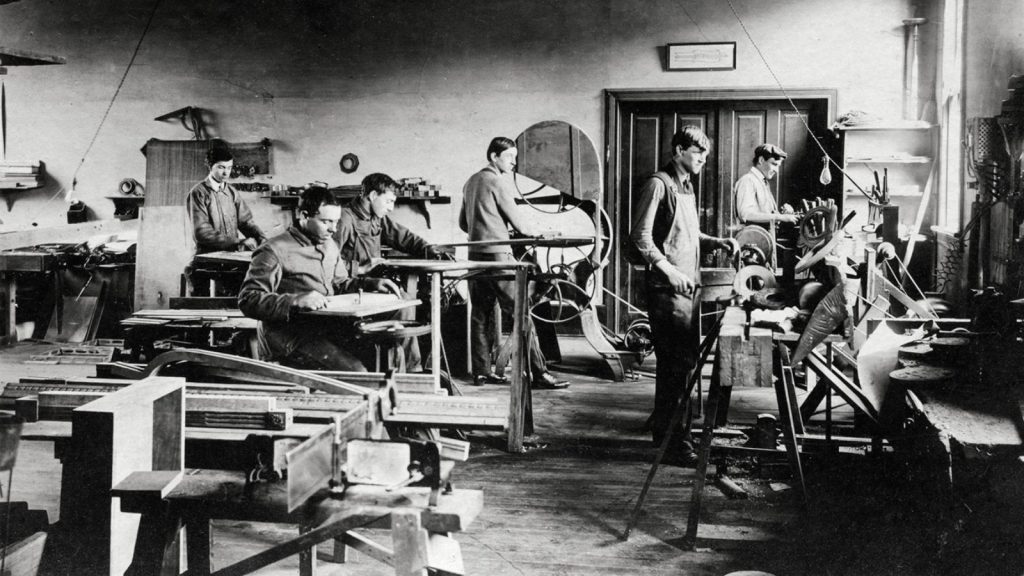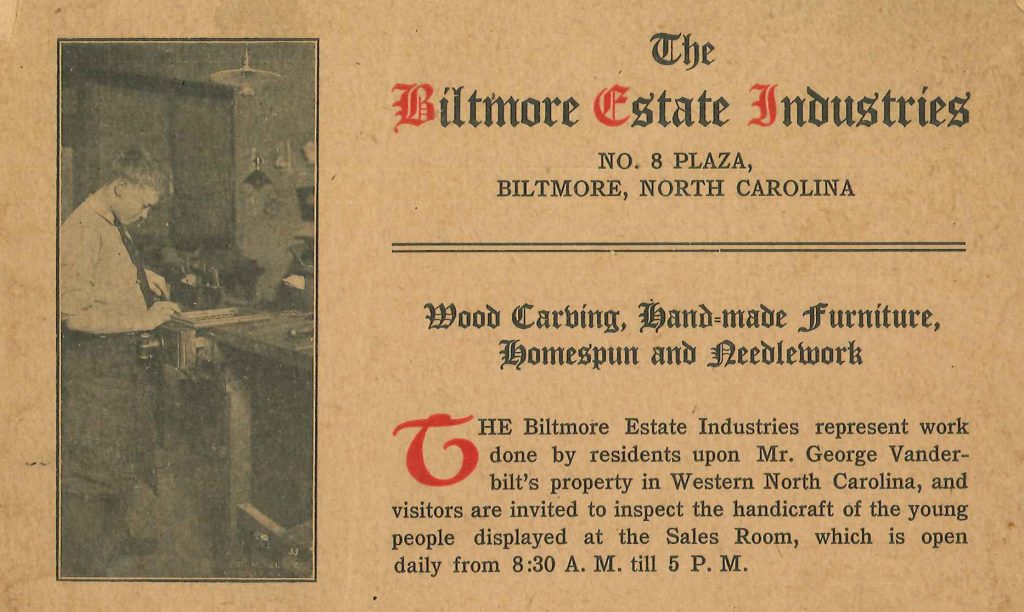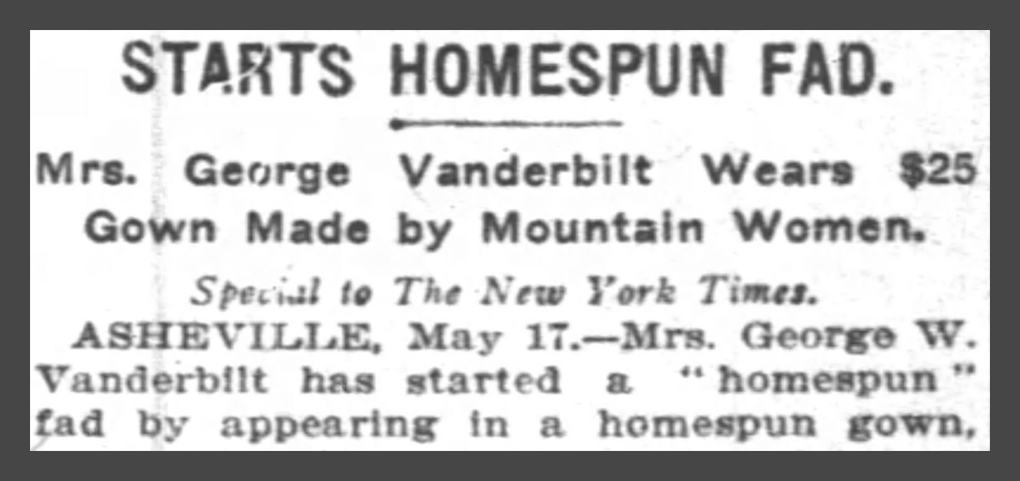When Edith Stuyvesant Dresser (1873–1958) married George Vanderbilt in 1898, she took on a large role as the mistress of Biltmore—the Vanderbilts’ 250-room château—with a gracious and generous spirit. As prominent members of the community, the Vanderbilts supported many philanthropic endeavors, including some on Biltmore Estate and in the greater Asheville community.

Eleanor Vance and Charlotte Yale, two young proponents of the arts and crafts movement, moved into a cottage in Biltmore Village in 1901. Once there, they were encouraged by the reverend Dr. Rodney Swope from All Souls’ Church to teach woodcarving to local boys. The Vanderbilts, Edith in particular, saw the merit in this type of practical training as a way for young people to learn beneficial skills. With Edith’s support, among others, the Boys’ Club of Biltmore Parish expanded to include girls (as well as needlework) and became the Boys’ and Girls’ Club, and ultimately Biltmore Estate Industries. What had started as simply learning a new skill developed into a means for craftspeople to support themselves by selling their artwork.
In its early years, George and Edith Vanderbilt personally supported Vance and Yale’s work through financial and material donations, as well as hosting them at Biltmore House. Eleanor Vance wrote in the 1903 All Souls’ Church yearbook: “In December, three of the most proficient workers were invited to Biltmore House to see the rare carving there. This invitation was not only an impetus to the boys but was an education, not one of them having ever seen wood carving before, except what they were doing themselves.”
By 1905, encouraged by Edith, members of the Boys’ and Girls’ Club added woven textiles to its woodworking repertoire. In 1906, the Vanderbilts gifted the students a workshop of their own in Biltmore Village and supplied all of the classroom materials. The classes were incorporated into a business enterprise, and Biltmore Estate Industries was born. It was also around this time that Edith selected Biltmore Estate Industries’ signature motto, “Forward,” on a scroll that is pierced by an arrow pointing to the right.

The 1907 All Souls’ Church yearbook speaks to Edith’s personal involvement and support: “The growth of the work and its wide extension among the tenantry of the estate are due to the enthusiasm and unfailing interest of Mrs. Vanderbilt. Her sympathy for the humble dwellers in the mountains, and her desire to better their condition by affording them larger scope for their activities, saw, in the woodworking, carving, embroidering, and weaving, agents exactly suited to the purpose and she has been tireless in her efforts to devise methods and enlist the co-operation of the people in her plans for their material betterment.”

Edith promoted the idea that Biltmore Estate Industries should produce an all-wool fabric, which she thought would make a finer grade of cloth that could be used for dressmaking as well as men’s suits and coats. Traditional mountain spinning characteristically produced a warp thread that was made of linen and wool, known as “linsey-woolsey,” so Edith sent Vance and Yale to England and Scotland to study the handweaving techniques that produced the famous Harris tweeds. She had a loom shipped from Scotland to serve as a prototype for new looms that were to be made of native oak by the boys in the woodworking class.
Initially, Edith wanted to have each wool processing step performed by different women in their homes. These cottage industry workers included carders, dyers, spinners, and weavers. Work was made available to as many women as possible on isolated parts of Biltmore Estate. Eventually, however, it became more cost-effective to have the weaving done at the workshop. It also became necessary to purchase wool from commercial growers to keep up with the orders instead of attempting to raise sheep on the estate for that purpose.
Edith Vanderbilt became an advertisement for Biltmore homespun cloth, which helped to generate interest in the product. On May 18, 1907, the following article appeared on the front page of the New York Times:
“Mrs. George W. Vanderbilt has started a ‘homespun’ fad by appearing in a homespun gown, of bright yellow, which she delights in telling cost just $25, and was made by a mountain woman near Biltmore … It has been through Mrs. Vanderbilt’s patronage that there has been a revival of the almost lost art of hand spinning and weaving among the mountain women.“

By 1909, Biltmore Estate Industries was profitable and no longer relied on the Vanderbilts to survive, but due to financial troubles associated with George’s sudden death in 1914 and the 1916 flood that affected Biltmore Village, Edith sold the business in 1917 to Fred Seely, builder and manager of the Grove Park Inn. Mr. Seely moved the operation closer to the Grove Park Inn, doubled the number of looms to 45, and renamed it Biltmore Industries. By 1921, the business was considered the largest hand-weaving industry in the world.
However, Edith Vanderbilt’s support of Biltmore Industries did not end with its sale. As the President of the North Carolina State Fair in 1921, she spoke in front of the general assembly in Raleigh while wearing, according to The Charlotte Observer on February 3, 1921, “a tailored suit of golden brown homespun, made at Grove Park Inn, where the industries started at Biltmore by Mrs. Vanderbilt and her late husband, are continued, with a small toque of the same shade Mrs. Vanderbilt made an attractive and pleasing appearance.”
Writing credit: Lauren Henry, Curator of Interpretation at Biltmore
